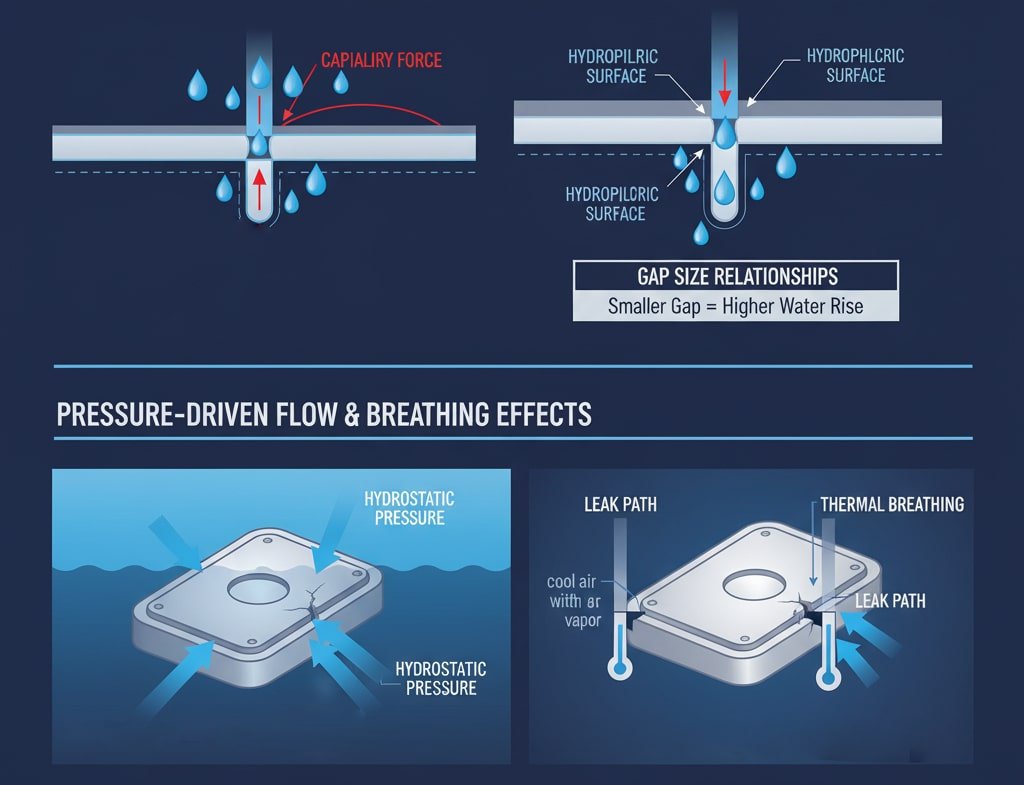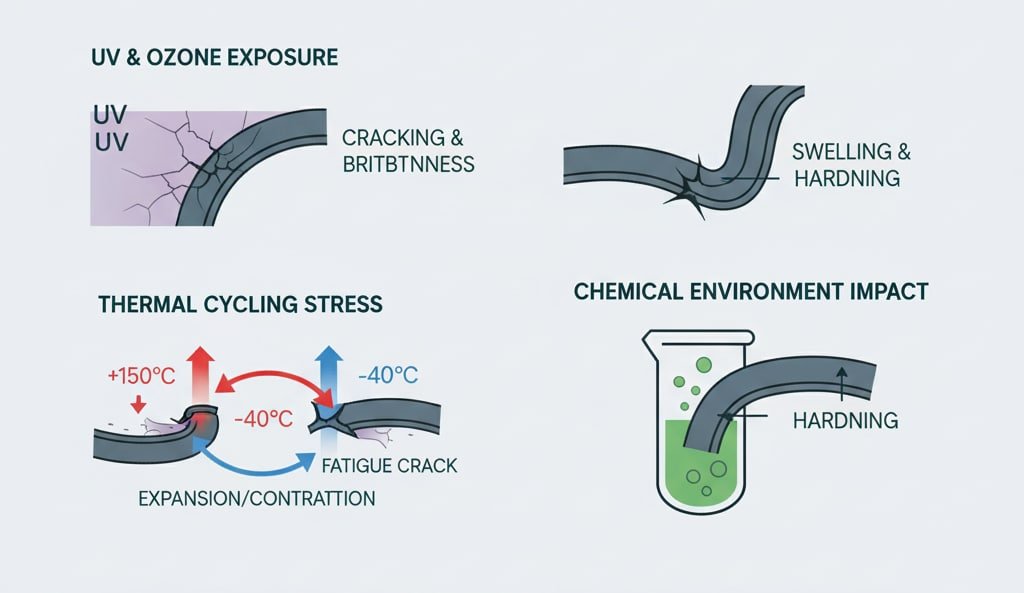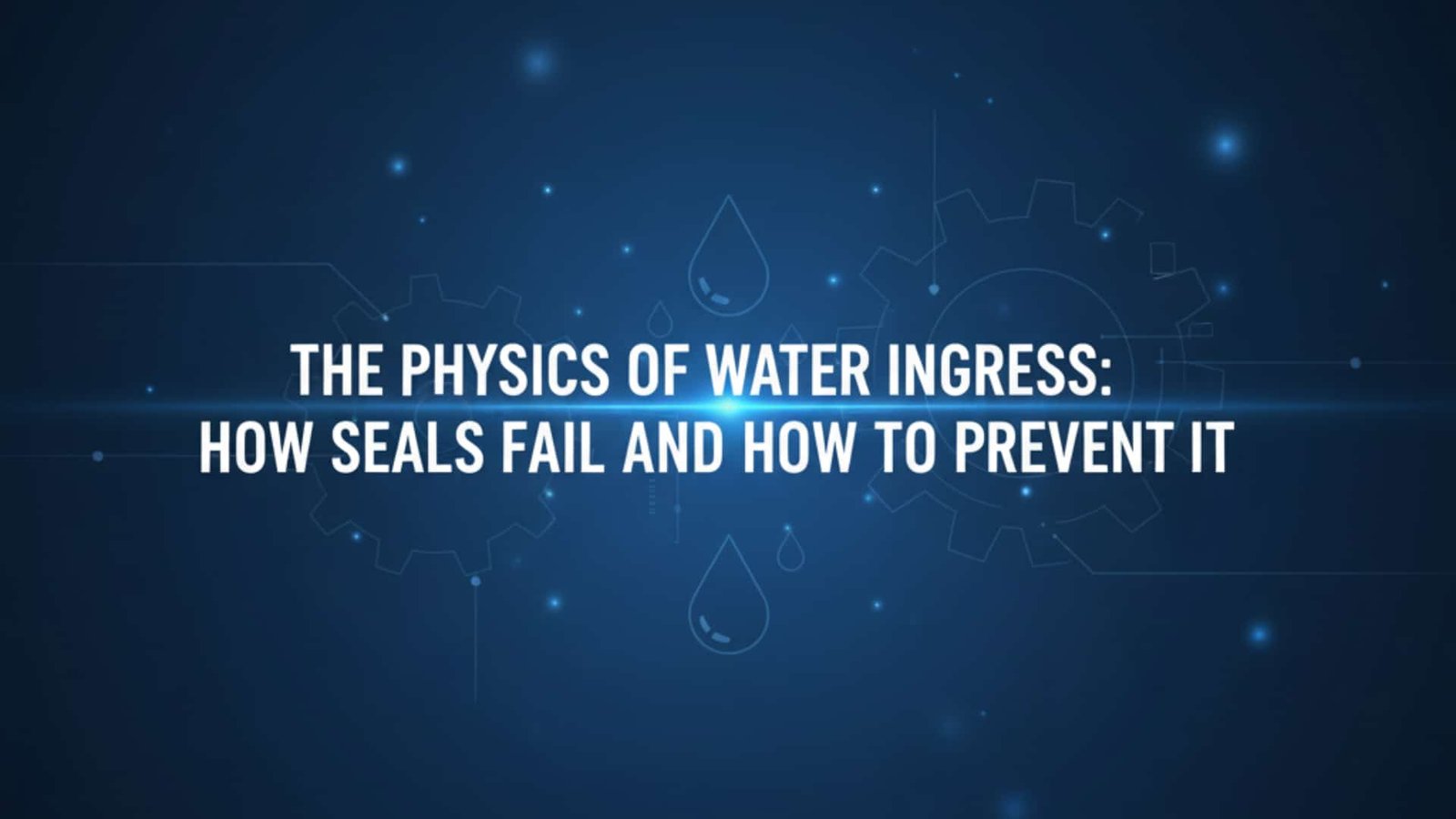Water ingress causes 85% of electrical system failures in outdoor applications, yet most engineers don’t understand the fundamental physics behind seal failure mechanisms. When seals fail, water penetrates electrical enclosures through microscopic pathways, creating short circuits, corrosion, and catastrophic equipment damage that can cost thousands in repairs and downtime. Water ingress prevention requires understanding capillary action, pressure differentials, thermal cycling effects, and material degradation mechanisms that compromise seal integrity, then implementing proper seal selection, installation techniques, compression ratios, and maintenance protocols to maintain long-term IP rating performance. After a decade of solving water ingress problems at Bepto, I’ve learned that successful sealing isn’t just about choosing the right materials – it’s about understanding the physics of how water moves and designing systems that work with natural forces rather than against them.
Table of Contents
- What Are the Primary Physics Behind Water Ingress?
- How Do Different Seal Materials Fail Under Water Pressure?
- What Environmental Factors Accelerate Seal Degradation?
- How Can You Design Systems to Prevent Water Ingress?
- What Are the Best Practices for Seal Installation and Maintenance?
- FAQs About Water Ingress Prevention
What Are the Primary Physics Behind Water Ingress?
Understanding water ingress requires knowledge of fundamental physical principles that govern how water penetrates sealed systems. Water ingress occurs through capillary action1 in microscopic gaps, pressure-driven flow through seal imperfections, osmotic pressure from concentration gradients, thermal expansion creating temporary gaps, and molecular diffusion through permeable materials, with each mechanism requiring specific prevention strategies based on the underlying physics.

Capillary Action and Surface Tension
Microscopic Pathways: Water molecules naturally flow into tiny gaps through capillary action, where surface tension forces pull water into spaces smaller than visible cracks.
Contact Angle Effects: Hydrophilic surfaces (low contact angle) promote water wetting and penetration, while hydrophobic surfaces (high contact angle) resist water ingress.
Gap Size Relationships: Capillary rise height is inversely proportional to gap width – smaller gaps actually draw water higher due to stronger surface tension effects.
Prevention Strategies: Use hydrophobic seal materials, eliminate microscopic gaps through proper compression, and design drainage paths for any water that does penetrate.
Pressure-Driven Flow Mechanisms
Hydrostatic Pressure: Water pressure increases linearly with depth (0.1 bar per meter), creating driving force for water penetration through any available pathway.
Dynamic Pressure Effects: Moving water, waves, or pressure washing creates additional pressure spikes that can overcome seal resistance temporarily.
Pressure Differential Calculations: Flow rate through gaps follows Poiseuille’s law2 – small increases in gap size cause exponential increases in water flow rates.
Breathing Effects: Temperature changes create pressure differentials that can draw water into enclosures during cooling cycles.
Marcus, a marine equipment engineer in Hamburg, Germany, struggled with repeated water ingress failures in offshore wind turbine junction boxes despite using IP67-rated cable glands. The problem was pressure cycling from wave action creating 2-3 bar pressure spikes that exceeded the static test conditions. We analyzed the physics and recommended our marine-grade stainless steel cable glands with dual O-ring seals designed for dynamic pressure conditions. The solution eliminated water ingress failures, achieving 36 months of reliable operation in North Sea conditions and preventing €150,000 in turbine downtime costs.
How Do Different Seal Materials Fail Under Water Pressure?
Seal material selection critically impacts water ingress resistance, with each material having unique failure mechanisms and limitations. Different seal materials fail through distinct mechanisms: rubber seals degrade from ozone and UV exposure, silicone seals lose compression set resistance, EPDM seals swell in certain chemicals, polyurethane seals crack under thermal cycling, and metal seals corrode or lose surface finish, requiring material selection based on specific application conditions and failure modes.
Elastomeric Seal Failure Modes
Compression Set3: Permanent deformation under constant compression reduces sealing force over time, creating gaps that allow water penetration.
Chemical Degradation: Exposure to oils, solvents, or cleaning chemicals causes seal swelling, softening, or hardening that compromises sealing effectiveness.
Temperature Effects: High temperatures accelerate aging, while low temperatures reduce flexibility and sealing force in rubber materials.
Ozone Cracking: Outdoor exposure to ozone creates surface cracks that propagate under stress, eventually allowing water pathways through the seal.
Material Property Comparisons
| Seal Material | Temperature Range | Chemical Resistance | UV Resistance | Compression Set | Typical Applications |
|---|---|---|---|---|---|
| NBR (Nitrile) | -40°C to +120°C | Good oils/fuels | Poor | Moderate | General purpose |
| EPDM | -50°C to +150°C | Excellent water | Excellent | Good | Outdoor/marine |
| Silicone | -60°C to +200°C | Limited chemicals | Good | Poor | High temperature |
| Viton (FKM) | -20°C to +200°C | Excellent chemicals | Excellent | Excellent | Chemical/aerospace |
| Polyurethane | -40°C to +80°C | Good abrasion | Moderate | Good | Dynamic sealing |
Metal Seal Considerations
Corrosion Mechanisms: Galvanic corrosion between dissimilar metals creates surface roughness that compromises sealing effectiveness.
Surface Finish Requirements: Metal seals require precise surface finishes (typically Ra 0.4-0.8 μm) to achieve effective sealing without excessive compression forces.
Thermal Expansion Matching: Different thermal expansion coefficients between seal and housing materials can create gaps during temperature changes.
Installation Sensitivity: Metal seals are more sensitive to installation damage and require careful handling to maintain sealing surfaces.
What Environmental Factors Accelerate Seal Degradation?
Environmental conditions significantly impact seal performance and longevity, requiring consideration during material selection and system design. Environmental factors that accelerate seal degradation include UV radiation causing polymer chain scission, ozone exposure creating surface cracking, thermal cycling inducing fatigue failure, chemical exposure causing swelling or hardening, mechanical vibration creating wear patterns, and humidity variations affecting material properties, each requiring specific mitigation strategies for long-term reliability.

UV and Ozone Exposure Effects
Polymer Chain Degradation: UV radiation breaks polymer chains in rubber materials, causing surface chalking, cracking, and loss of elasticity.
Ozone Attack Mechanisms: Ozone reacts with unsaturated bonds in rubber, creating surface cracks that propagate under stress and eventually allow water penetration.
Protection Strategies: Use UV-stabilized materials, apply protective coatings, or design physical barriers to shield seals from direct sunlight exposure.
Material Selection: EPDM and silicone offer superior UV/ozone resistance compared to natural rubber or basic synthetic rubbers.
Thermal Cycling Stress
Expansion/Contraction Cycles: Repeated thermal expansion creates mechanical stress that can cause fatigue cracking in seal materials over time.
Glass Transition Effects: Low temperatures can cause rubber materials to become brittle and lose sealing effectiveness temporarily.
Thermal Shock Resistance: Rapid temperature changes create higher stress levels than gradual temperature variations.
Design Considerations: Allow for thermal movement in seal design and select materials with appropriate temperature ratings for application extremes.
Chemical Environment Impact
Swelling and Softening: Incompatible chemicals cause seal materials to swell, reducing compression force and creating potential leak paths.
Hardening and Cracking: Some chemicals cause seal materials to harden and lose flexibility, leading to crack formation under stress.
pH Effects: Extreme pH conditions (very acidic or basic) can cause chemical degradation of seal materials over time.
Cleaning Agent Compatibility: Industrial cleaning chemicals can be particularly aggressive toward seal materials, requiring careful material selection.
Ahmed, a facility manager at a petrochemical plant in Dubai, UAE, faced constant seal failures in cable glands exposed to high-temperature steam cleaning (85°C) and aggressive degreasing chemicals. Standard EPDM seals degraded within 6 months, causing water ingress during washdown procedures. We recommended our specialized Viton-sealed stainless steel cable glands designed for chemical processing environments. The solution provided 24+ months of reliable service, eliminating production disruptions and ensuring compliance with food safety regulations while reducing maintenance costs by 70%.
How Can You Design Systems to Prevent Water Ingress?
Effective water ingress prevention requires systematic design approaches that address multiple failure modes and environmental conditions. System design for water ingress prevention involves implementing multiple sealing barriers, designing proper drainage paths, selecting compatible materials, calculating appropriate compression ratios, considering thermal expansion effects, providing maintenance access, and incorporating monitoring systems to detect early seal degradation before catastrophic failure occurs.
Multiple Barrier Design Philosophy
Primary and Secondary Seals: Implement redundant sealing systems where primary seal failure doesn’t immediately compromise system integrity.
Labyrinth Seal Concepts: Create tortuous paths that make water penetration difficult even if individual seals are compromised.
Pressure Relief Systems: Design venting systems that prevent pressure buildup while maintaining water ingress protection.
Compartmentalization: Isolate critical components so that localized seal failure doesn’t affect entire system operation.
Proper Compression Ratio Calculations
Optimal Compression Range: Most O-ring seals require 15-25% compression for effective sealing without excessive stress that causes premature failure.
Groove Design Standards: Follow established standards (AS568, ISO 3601) for O-ring groove dimensions to ensure proper compression and retention.
Tolerance Stack-up Analysis4: Consider manufacturing tolerances that affect final compression ratios and design accordingly.
Installation Tools: Provide proper installation tools and procedures to achieve consistent compression ratios during assembly.
Drainage and Venting Design
Water Management: Design drainage paths for any water that penetrates outer sealing barriers to prevent accumulation.
Breathable Membranes: Use Gore-Tex or similar membranes that allow air exchange while blocking liquid water penetration.
Condensation Control: Design systems to manage internal condensation that can be as damaging as external water ingress.
Maintenance Access: Ensure sealing systems can be inspected, tested, and replaced without major system disassembly.
What Are the Best Practices for Seal Installation and Maintenance?
Proper installation and maintenance practices are crucial for achieving designed seal performance and longevity. Best practices for seal installation and maintenance include proper surface preparation and cleaning, correct lubrication selection and application, achieving specified compression ratios, avoiding installation damage, implementing regular inspection schedules, monitoring performance indicators, replacing seals before failure, and maintaining detailed service records for reliability analysis and improvement.
Installation Best Practices
Surface Preparation: Clean all sealing surfaces to remove dirt, oil, old seal residue, and any contaminants that could compromise sealing effectiveness.
Lubrication Selection: Use compatible lubricants that don’t degrade seal materials – silicone grease for most applications, specialized lubricants for chemical environments.
Installation Tools: Use proper installation tools to avoid nicking, twisting, or damaging seals during assembly procedures.
Torque Specifications: Follow manufacturer torque specifications to achieve proper compression without over-tightening that damages seals or threads.
Preventive Maintenance Programs
Regular Inspection Schedules: Establish inspection intervals based on application severity – monthly for critical applications, annually for standard installations.
Performance Testing: Conduct periodic pressure tests or IP rating verification to confirm continued sealing effectiveness.
Predictive Indicators: Monitor for early warning signs like minor leakage, visible seal degradation, or changes in system pressure retention.
Replacement Criteria: Replace seals based on condition assessment rather than arbitrary time intervals for optimal cost-effectiveness.
Documentation and Tracking
Service Records: Maintain detailed records of seal installations, replacements, and performance to identify patterns and optimize maintenance intervals.
Failure Analysis: Investigate seal failures to understand root causes and improve future designs or maintenance practices.
Material Traceability: Track seal material lots and suppliers to identify quality issues and ensure consistent performance.
Training Programs: Provide proper training for installation and maintenance personnel to ensure consistent, high-quality work.
Conclusion
Understanding the physics of water ingress enables engineers to design more effective sealing systems and prevent costly failures through proper material selection, installation practices, and maintenance programs. By addressing capillary action, pressure differentials, material degradation mechanisms, and environmental factors, we can create robust sealing solutions that maintain IP ratings throughout their service life. At Bepto, our decade of experience solving water ingress challenges has taught us that successful sealing requires both technical knowledge and practical application expertise – we’re here to help you implement these principles in your specific applications for reliable, long-term performance 😉
FAQs About Water Ingress Prevention
Q: What’s the most common cause of water ingress in electrical enclosures?
A: Poor installation practices cause 60% of water ingress failures, including inadequate surface preparation, incorrect compression ratios, and damaged seals during assembly. Proper training and installation procedures prevent most failures.
Q: How do I choose the right seal material for my application?
A: Select based on temperature range, chemical exposure, UV/ozone resistance requirements, and compression set resistance needs. EPDM works for most outdoor applications, while Viton handles chemical environments and high temperatures.
Q: Can I test seal effectiveness without disassembly?
A: Yes, use pressure decay testing, helium leak detection, or IP rating verification tests to assess seal performance. Monitor pressure retention over time or use tracer gases to detect microscopic leaks before they become problems.
Q: How often should I replace seals in outdoor applications?
A: Replace based on condition rather than time – typically 3-5 years for EPDM in moderate climates, 2-3 years in harsh UV/ozone environments. Inspect annually and replace when degradation signs appear.
Q: What’s the difference between IP67 and IP68 ratings for water protection?
A: IP67 protects against temporary immersion (1 meter for 30 minutes) while IP68 provides continuous submersion protection at manufacturer-specified depth and duration. Choose based on actual water exposure conditions in your application.
-
Explore the physical phenomenon where liquid flows into narrow spaces without external forces, driven by surface tension and adhesive forces. ↩
-
Understand the fluid dynamics principle that describes the pressure drop of a fluid flowing through a long cylindrical pipe or gap. ↩
-
Learn about the permanent deformation of elastomeric materials after prolonged compressive stress, a key factor in long-term sealing performance. ↩
-
Discover the engineering analysis method used to calculate the cumulative effect of part tolerances on an assembly’s final dimensions and fit. ↩



